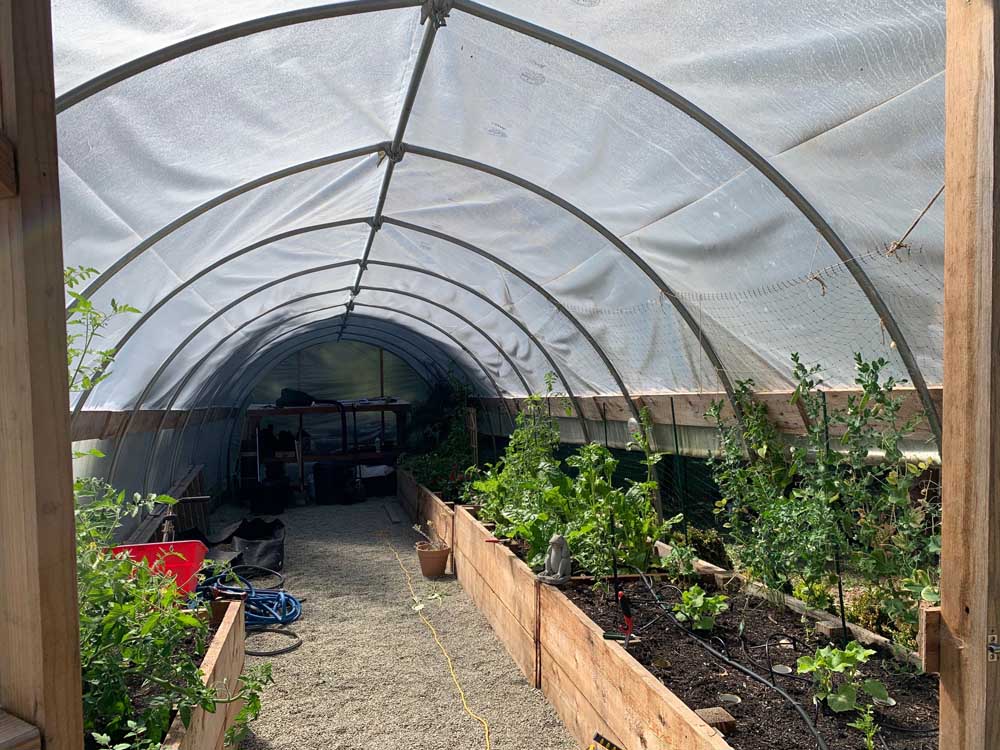GARDEN PLOTS: Judging a greenhouse by its cover
Published 7:00 am Wednesday, April 17, 2024

- The author’s hoop house in Bandon has a single layer of unwoven polyethylene covering the frame. Clear plastic permits more direct sunlight to enter the enclosed space.
“The sun is what truly raises the temperature … so the less of it that actually gets to the greenhouse, the better it can be for the temperature and for your plants.”
— Jessie Kelias, “Not Too Hot, Not Too Cold,” 2023
This month, I’ve been discussing some of the strategies author Jessie Kelias recommends for effectively managing greenhouse temperatures. I’ve talked about the importance of considering local weather and microclimates and providing sufficient ventilation. Last week, I mentioned the usefulness of providing shade with cloth or trees to reduce the amount of direct sunlight entering the greenhouse.
One topic Kelias doesn’t cover in her book but is nonetheless important for controlling greenhouse temperatures is the type of material that is used over the frame. There are a variety of plastics that can be used for their insulation and light-diffusion qualities, as well as other features such as anti-drip, anti-dust, anti-fog, infrared tinting and UV protection.
My 12-foot-by-20-foot greenhouse material is 8 mm woven polyethylene, which is more durable and puncture-resistant than thinner 3 or 6 mm PE but not as thick as 11 mm PE. Additives for protection from ultraviolet rays have slowed degradation of the plastic significantly and increased light diffusion. According to some studies, plant growth is accelerated by 25-30% under diffused light.
Woven PE has a matte side and a shiny side. When the shiny side is placed on the outside, there is less light diffusion than when the sun hits the matte side first. My greenhouse plastic is opaque, which filters more light than the 6 mm clear plastic I’ve used for my 12-foot-by-40-foot hoop house in Bandon. I’ve found this is an appropriate choice because the opaque PE helps to reduce greenhouse temperatures in our warmer climate in Medford, and the clear PE permits more direct sunlight in the hoop house for the cooler Bandon climate.
Although woven polyethylene lasts longer than non-woven PE (five to seven years as opposed to two or three years), keep in mind that woven PE is more expensive and doesn’t stretch, which makes it more difficult to place on the greenhouse frame.
Greenhouse coverings have different R-values, which measure how well the material prevents the flow of heat into and out of the greenhouse. A higher R-value means greater insulation. Coverings also have different U-values, which measure heat loss through the material. Lower U-values allow less heat to escape.
My single-layer, 8 mm polyethylene film has an R-value of 0.85. I could increase the R-value to 1.70 by using a double layer of non-woven plastic and pumping air in the space between the layers. (Double layers of woven PE are too heavy to inflate.) Of course, the downside to increasing greenhouse insulation is added heat buildup within the enclosed space.
Solexx sheets are twin-walled polyethylene plastic that are available in thicknesses of 3.5 mm or 5 mm (3.5 mm sheeting permits more sunlight to penetrate). They are more expensive than PE film, but they last longer and are effective at diffusing light evenly throughout the greenhouse, thus reducing hot spots and shadows for better plant growth. Solexx sheets that are 3.5-mm thick have an R-value of 2.10 and a U-value of 0.48.
Another common greenhouse material is polycarbonate, a rigid plastic that is often used as a less expensive glass alternative. Most greenhouses use 6 mm twin-wall PC panels that have an R-value of 1.54 or 8 mm twin-wall panels with an R-value of 1.60. U-values for double-walled PC panels at the same thicknesses are 0.65 and 0.63, respectively. Although PC panels are as durable as Solexx panels, they are more expensive and the panels are available in limited sizes, whereas Solexx panels can be cut to fit the size needed.
When deciding which greenhouse material makes the most sense for you, it’s helpful to consider its recyclability. I learned that plastic products are numbered from 1 to 7 that indicates the type of plastic used and how easily it is recycled. One means the plastic is easier to recycle, and 7 means the plastic is not as easily recycled. Keep in mind that even plastics marked with lower numbers may not be accepted for recycling in a particular area.
Most plastic greenhouse films are made from low-density polyethylene, similar to plastic bags, shrink wrap and some plastic containers. These plastics have a recycle rating of 4, which means they can be recycled but the process is more complex, so they are usually not accepted in curbside recycling programs.
On the other hand, Solexx sheeting is made from high-density polyethylene, which has a recycle rating of 2, similar to plastic milk jugs and detergent bottles. This type of plastic material is easier to recycle than low-density polyethylene. Polycarbonate is considered a medium-density plastic and can be recycled by shredding the panels into granules.
I hope I’ve taken some of the guesswork out of selecting a plastic covering for your greenhouse frame. Next week, I’ll share some insights on managing greenhouse temperatures from OSU Master Gardeners at the Southern Oregon Research and Extension Center in Central Point.






